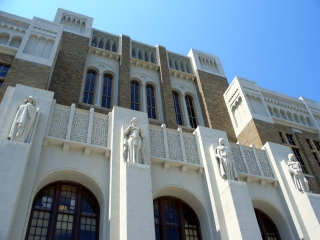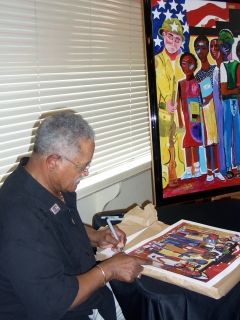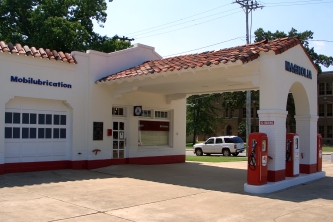NPS Website; Local Website
WHAT IS IT?
Little Rock High School where, in September 1957, nine black students challenged the Constitution’s separate but equal clause through integration of the public school system.
 BEAUTY (5/10)
BEAUTY (5/10)Central High School looks like, well, a high school; a high school built in the tradition of bricks and towers, accentuated by grand pillars and steps leading to large front doors that open up to a gymnasium, a symmetrical floor design and a few stories of cookie cutter classrooms. This mix of Art Deco and Collegiate Gothic design is familiar on college campuses and on many secondary schools built in the 1920s. Central High is framed by a large front lawn and reflecting pool. The building is impressive and traditional.
The former Magnolia Gas Station across the street from the still-functioning high school houses the Site’s Visitor’s Center. Minor attempts have been made to give the exterior of the building a nostalgic feel, like the old Mobil sign and antiquated gas pump, but it pales in stature and relevance to the actual historical property of the high school.
HISTORICAL INTEREST (7/10)
The four white pillars guarding the entrance of Central HS are named, Ambition, Personality, Opportunity and Preparation. Until September 23rd of 1957 when the first nine black students entered the high school by way of armed escort from the US National Guard, these values were limited to the white student body inside.
The 1954 Brown v. Board of Education of Topeka decision affirmed that racial segregation in public schools was unconstitutional but Arkansas was slow to move towards integration. When 27 African-American students attempted to register in all-white Little Rock schools in 1956 and were denied, the National Association for the Advancement of Colored People (NAACP) moved from petitioning the state to filing a lawsuit.
Arkansas’ Governor Orval E. Faubus still wouldn’t budge. With the strong support of local segregation groups such as the Mother's League of Central High School and the Capital Citizens Council, Governor Faubus stationed the Arkansas National Guard in front of the pillars of Central High to prevent nine African-American students, now known as the Little Rock Nine, from entering.
When the Arkansas Guard barred several attempts by the Little Rock Nine to enter the school and the angry mob looked as if it could turn violent towards the young students, President Dwight D. Eisenhower became the first presidents since the post-Civil War Reconstruction period to use federal troops in support of African-American civil rights.
The nine African-American students finally attended school towards the end of September 1957, but the rest of the school year was equally trying. Faced with federal intervention, an obstinate governor and dueling ideologies, Central HS and the town of Little Rock gradually accepted integration in its public schools. The Central HS NHS recognizes this struggle and the sacrifices and bravery of the Little Rock Nine.
Nobel Prize winning author John Steinbeck witnessed the 1957 Little Rock turmoil and played a significant role in cross-country travelouge, Travels with Charley.
 CROWDS (7/10)
CROWDS (7/10)Far too many people for the Mobil Gas Station a/k/a Visitors Center to hold. But our visit coincided with the unveiling of a new series of U.S. Postal Stamps commemorating events and sites of the Civil Rights Movement entitled, “To Form a More Perfect Union.”
We just missed a presentation by Melba Pattillo Beals, a member of the Little Rock Nine, in the school’s gymnasium. By the time we arrived, the audience was already stretched in a line outside the door to get their prints and cancelled stamps of “America Cares” autographed by the artist George Hunt.
Space was tight but the atmosphere was celebratory. We just wished we had heard of the day’s events before our late arrival.
EASE OF USE/ACCESS (4/5)
Central HS is located just west of downtown Little Rock. Take either exit 3A or 2B from Interstate 630. From 3A go south on Woodrow Street and turn left on Daisy L. Gatson Bates Drive. From 2B go south on Martin Luther King Jr. Drive and turn right on Bates Drive. The Museum is located in a refurbished Mobil station at the corner of Bates Dr. and Park St. The High School is across the street.
Central is still a working high school and not open to the public during the school year.
CONCESSIONS/BOOKSTORE (3/5)
The tiny Bookstore’s space constraints became very apparent during our visit.
The artist who designed the Little Rock Nine postage stamp was autographing prints of his newly honored work. The line stretched out the door. The crowded confines did not prevent us from being disappointed, yet again, by the book selection at a Civil Rights-related park site. If one were to judge the Site’s historical importance via the number of books written about it (and on sale in its bookstore) then the Little Rock Nine would not seem that significant at all.
COSTS (4/5)
The Site’s small Museum is free.
RANGER/GUIDE TO TOURIST RATIO (4/5)
Several brown uniformed members of the Park Service were present to assist with the USPS event, but none were available to help us interpret the museum or High School grounds.
TOURS/CLASSES (5/10)
Since our visit was during the school year and classes were in session, access to Central High School is very limited. Visitors are free to wander the grounds of the high school, stroll through the small commemorative garden or browse the exhibits in the Magnolia Gas Station building. Ranger-led group tours of the exterior of the high school can be specially arranged ahead of time.
We snuck into the HS gymnasium where USPS and NPS workers were still busy selling products from the morning’s presentation. It looked like a high school gymnasium.
Exhibit panels in the Visitors Center are descriptive and poignant, but an introductory film or something more than 2-dimensional would have greatly aided our visit. There are big plans to build a new VC in time for the 2007 50th Anniversary of the integration of Little Rock Central HS. We hope they can raise the funds and construct the new Center in time.
 FUN (5/10)
FUN (5/10)The large crowd caught us off guard. It took us a few minutes to assess the situation and figure out what was happening (or had just happened) at the Site. We were caught up in the excitement of the event, even though we hadn’t actually attended it ourselves.
The limited access to the actual historic site was disappointing, but we probably could have figured that out had we thought about it beforehand. In fact, the more we thought about it, Central HS is probably one of the more accessible high schools we have seen. Few schools would be ok with random and frequent visitors touring their grounds these days.
WOULD WE RECOMMEND? (6/10)
Central HS is one of Little Rock’s most impressive buildings. Its history is undeniable. However, there is little to do once you arrive. Our visit lasted less than an hour, and that was with all the fanfare of the US Postal Service event. We suggest waiting until 2007 when the new Visitors Center is up and running. It is clear from the attendance of the day’s commemorative event that the community of Little Rock cares about this story. We have no doubt that the new VC will be more interactive and worth a lengthier visit.
TOTAL 50/80
www.usa-c2c.com
© 2005